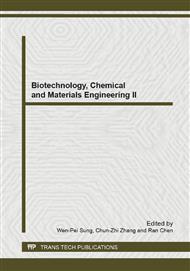p.803
p.808
p.812
p.816
p.820
p.824
p.828
p.834
p.838
The Effect of T-7 Peptide on Human Non-Small-Cell Carcinoma A549 Cells
Abstract:
7 peptide of Tumstatin(T-7 peptide) is composed of 185-191 amino acids. To study T-7 peptide antitumor activity to human non-small-cell carcinoma(A549), T-7 peptide was designed and synthesized by amino acid synthesizer. Its purity ran up to 98.45% by HPLC and MS. The effect of T-7 peptide on A549 cell growth was observed by MTT assay, growth curve and transmission electron microscopy(TEM). T-7 peptide had the effects of suppressing A549 cell growth and promoting its apoptosis, showing dose- and time-dependent. Its IC50 was 92.84 μg/ml. TEM also revealed that A549 cell treated with T-7 peptide appeared apoptotic morphology,such as cell pyknosis and mitochondrial vacuoles formed. While T-7 peptide had little effect on human umbilical vein endothelial cells(ECV304). These researches were significant to treat human non-small-cell carcinoma in the future.
Info:
Periodical:
Pages:
820-823
Citation:
Online since:
January 2013
Authors:
Price:
Сopyright:
© 2013 Trans Tech Publications Ltd. All Rights Reserved
Share:
Citation:


